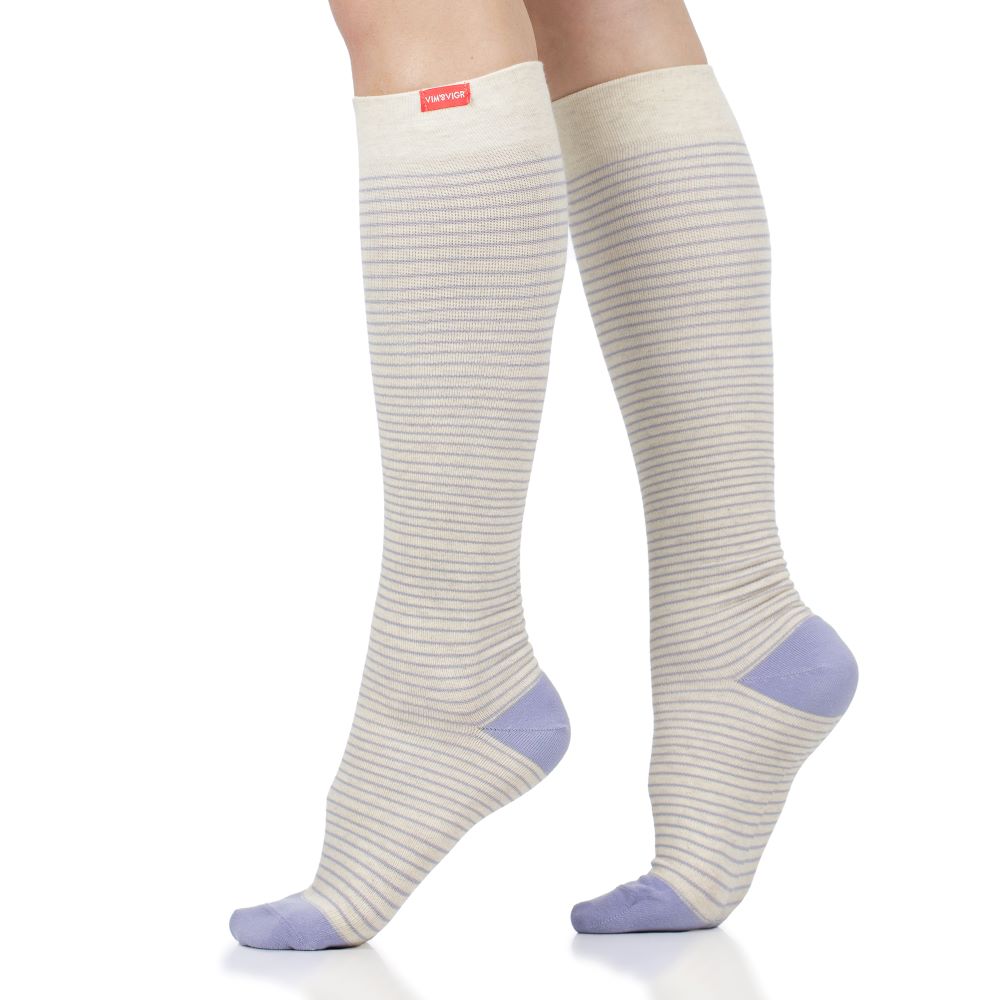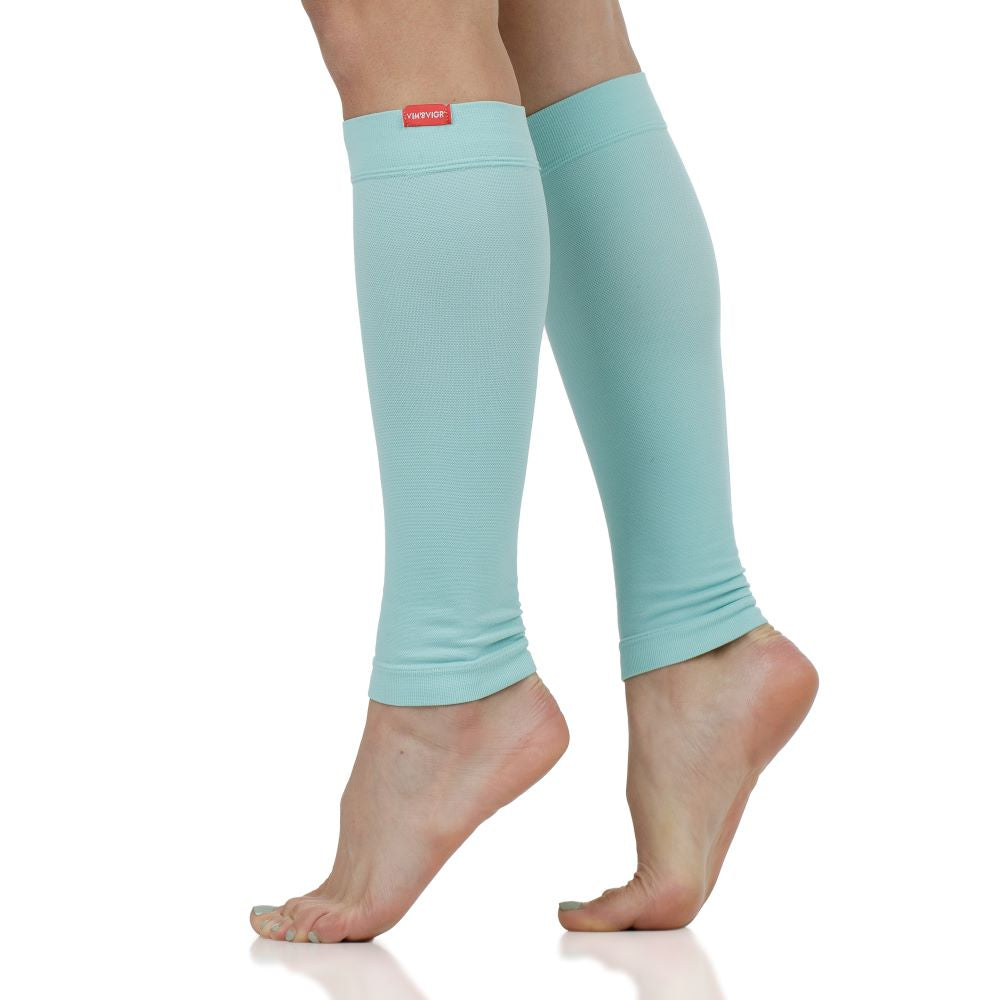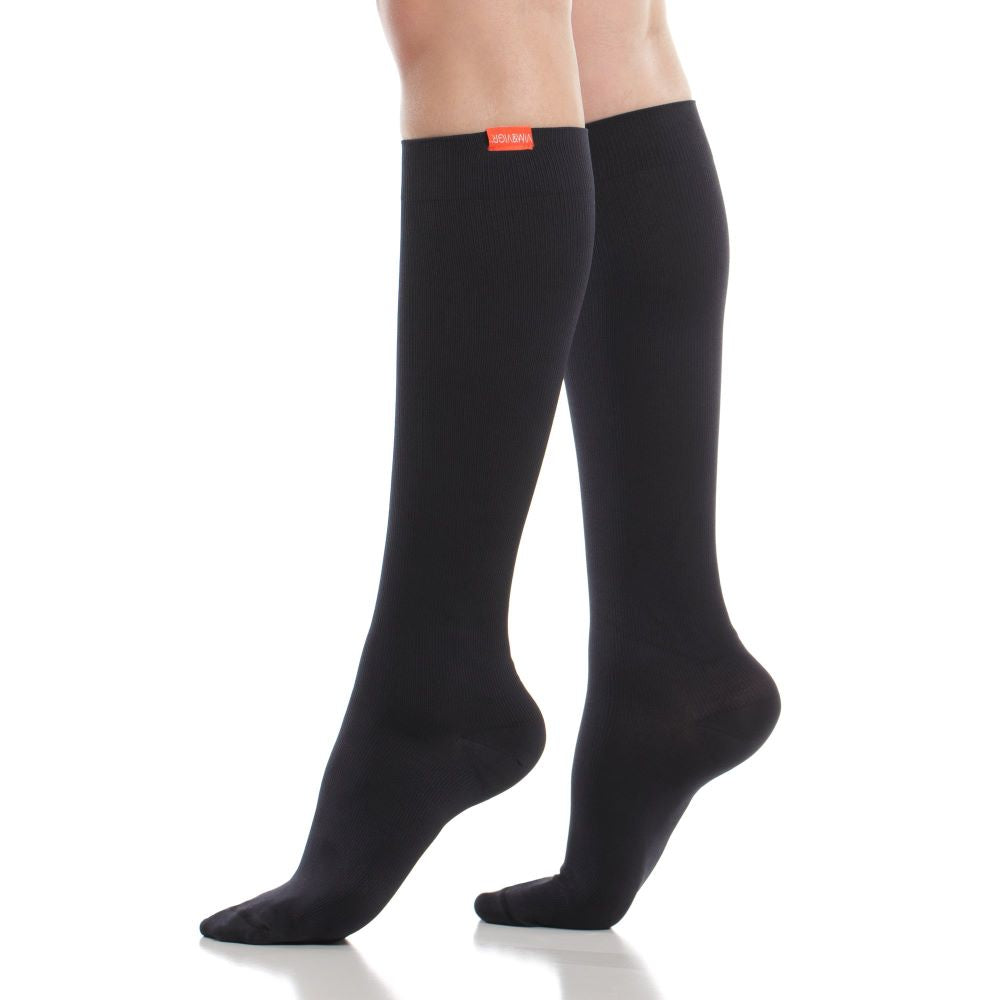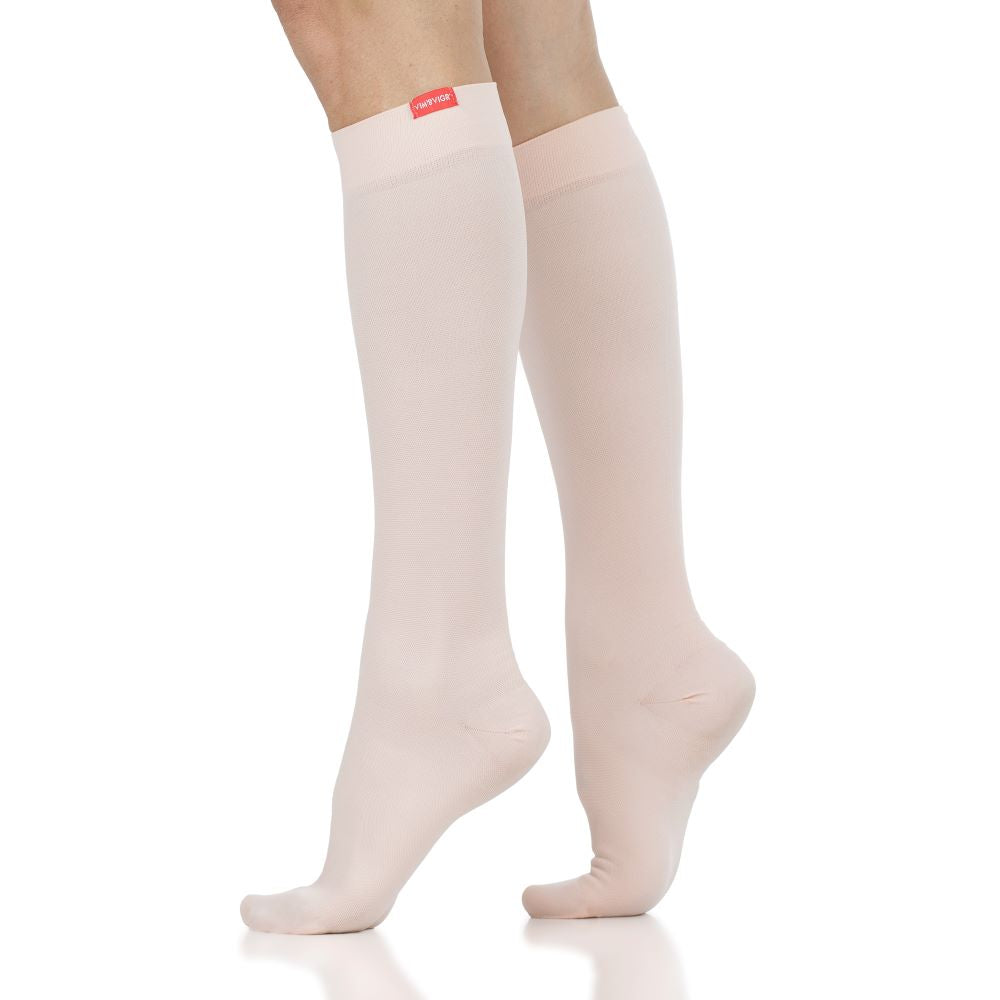8 Merino Wool Benefits + Reasons to Wear Merino Wool Socks
When it comes to choosing the best fabric for your compression socks, there is a wide variety of possible options. Depending on the activity, your preference, and weather conditions, Merino wool can be a top choice for your next pair of socks.
Thanks to its moisture wicking, temperature regulating properties, Merino wool is a great material for active people who need breathable and comfortable compression socks. It also provides protection from odors, it is anti-static and easy to care for.
In this article, we’ll look at the top benefits of choosing Merino wool for your compression socks, as well as how to wear it and why you should buy Merino wool compression socks.

8 Merino Wool Benefits
This versatile material, made from wool fibers from Merino sheep, has been used in garment making for centuries. Hailed by Europeans who have been breeding these sheep in Spain and France, it spread around the world. Thanks to being adaptable and hardy, the Merino sheep are very popular today, and their wool is used in clothing that’s appreciated for its soft, fine fleece. Here are the top reasons why Merino wool is so great.
Moisture wicking and breathable
Firstly, one of the chief qualities of Merino wool is its ability to regulate moisture, absorbing water molecules. Wool fibers in general attract water, with Merino specifically being able to absorb up to 30% of their weight in moisture and still feel dry to the touch.
Regular wool becomes heavy when imbibed with lots of water, but Merino wool not only takes the moisture in, it also releases it efficiently into the air. This means that a pair of Merino wool socks will wick moisture away from your feet, then release it out in the air, keeping you feeling dry and light.
This material is also highly breathable, thanks to its ability to transport water away from the skin. Breathability effectively means not creating any barriers to gas flow (in this case, air). Because garments are usually a barrier, and become wet, regular fibers that don’t absorb and release water are less breathable. This is where Merino wool shines – helping those wearing Merino garments feel a lot more comfortable than others.
Durable and long-lasting
Merino wool has been incorrectly given a bad reputation around durability. While manufacturers may choose to make very thin Merino wool garments, this is because a lot of them are used as base layers – the first layer of clothing you put on against the skin, to keep you warm and dry. However, it is not the Merino fiber that’s at fault here, but rather the thinness of the clothing and the way it is cared for.
With Merino wool socks, thinness is not so much of a problem. Additionally, the actual Merino fiber is very resilient, provided you treat the garments with care. Merino wool socks can easily last for many years, providing a good investment.
Odor resistant and anti-microbial
Ever wondered why our garments smell so much when we sweat? It’s because of the secretions from apocrine glands (in the armpits, groin, ears, and other parts of our bodies) that mix with bacteria from the skin. The latter grow in warm, humid environments, so if you’re sweating, there is more of them. When the bacteria come in contact with the secretions, they most often eat them and break them down into acid that smells bad.
As Merino wool absorbs moisture, it doesn’t allow the bacteria to proliferate quite so much on your skin. Additionally, lanolin (the natural wax that is part of wool) fights off lingering bacteria. And, with Merino wool specifically, there is a different structure that has neutral electric charge and is unpopular with bacteria.
All these factors combine to not only help Merino wool garments be a lot less smelly when we sweat, but also to make them anti-microbial. A win-win!
Anti-static
Due to the natural neutral electric charge we’ve mentioned and its ability to absorb water vapors, Merino wool is anti-static. That’s because static electricity builds up in low humidity environments (think of the tumble dryer!) when pieces of clothing rub together. But, since Merino wool holds water, it doesn’t get as dry as other fabrics.
Another linked benefit to this is that Merino wool clothing is less likely to stain. Bacteria are fought off and the anti-static properties repel dust and grime, so most sources of stains are easily eliminated when you wear Merino wool garments.
Natural and hypoallergenic
Many people struggle with allergies and think they would have problems with Merino wool because traditional wool clothing is so itchy. However, Merino wool is composed of keratin, which is the same protein we find in our own skin and hair (think of the keratin infused shampoos!).
This means that Merino wool has very similar composition to human skin, effectively making it extremely unlikely to develop an allergy to it. Moreover, keratin is a gentle and protective layer that irritates skin a lot less than synthetic fibers or cotton. This naturally hypoallergenic composition makes Merino a great fabric for people who suffer from rashes, eczema etc.
No itch
The reason traditional wool garments feel so itchy is that their coarse fibers rub against the skin. This is sometimes due to cheaper wool being used, and also because wool fibers are often shorter in length, leading to fraying that then makes the material feel rough on the skin.
Merino fibers are thinner than traditional wool (around half as thick), which makes them more flexible and less likely to fray. Their thinness and softness make them more comfortable, with fewer loose threads that could cause itching.
Easy care
Merino wool doesn’t wrinkle, doesn’t retain bad odors and dries well and easily naturally. This makes it very easy to care for – all you need to do is wash it in a gentle cycle and leave out to dry.
Moreover, the fact that Merino wool doesn’t wrinkle so much makes it ideal for long travels, where you’ll finish a trek or a plane ride looking a lot fresher than those wearing synthetics or cotton.
Sustainable and biodegradable
It’s a shocking fact that 20% of global production waste comes from the textile and apparel sectors. What’s worse, synthetic fabrics take between 20 and 200 years to break down, compounding the problem in the near future.
Depending on the blend, if you discard a wool garment, it will take between 1 and 5 years for it to decompose. All-natural Merino takes only six months. This is a massive advantage in terms of sustainability, although we would expect that you’ll want to keep your Merino wool socks for many years, rather than throw them out!

Does Merino Wool Keep You Warm Like Regular Wool?
Merino wool is excellent at keeping the body warm thanks to the way it regulates moisture and air exchanges. A pair of Merino wool compression socks holds warmth even when they get wet on the trails.
The natural crimp in the fiber of Merino wool traps heat from your body in air pockets that keep you warmer for longer than traditional wool or other fabrics. If you use a Merino base layer underneath other clothing, that gives you added comfort against the elements, without sweating or smelling bad.
Does Merino Wool Layer Well?
Because Merino wool fabric has a natural crimp that allows it to trap warm air generated by your body and keep you toasty, it’s actually an ideal base layer underneath other clothes. Moreover, Merino wool base layers can be thin and comfortable, yet very effective at wicking away moisture and keeping bad smells from developing. Wearing a thin Merino wool top and leggings, along with a pair of Merino wool compression socks, sets you up for a warm and dry day wherever you are. And you won’t end up dressing like a cartoon character and appearing all bulky, either!
What are the Benefits of Merino Wool Socks?
Socks made from Merino wool are great in all weather conditions, super soft, warm and dry. Because of the fabric’s ability to wick away moisture, Merino wool socks are an excellent choice for everyday wear, but also for more outdoorsy activities like walking and hiking. You won’t need to worry about your feet getting wet if you get caught in the rain or pass through a river! Your feet will dry quicker and stay warm, too.
In the summer, Merino wool socks wick away sweat and provide improved breathability compared to other materials.
Finally, because they are so soft and flexible, Merino wool socks are extremely comfortable. They’re much less likely to rub and cause hot spots or blisters on long walks, and they’ll keep your feet feeling happy and light.
Why Choose Merino Wool Compression Socks?
Combining the benefits of Merino wool with those of compression, Merino wool compression socks tick so many boxes:
- They are moisture wicking and odor repellant, keeping your feet in great shape no matter how far you walk;
- They keep you warm in the cold and cool in the heat;
- They dry quickly, preventing the build-up of hot spots or blisters;
- Graduated compression stimulates blood flow in the lower limbs, preventing the development of blood clots, as well as keeping your legs light and breezy;
- They combat any aches and pains in the legs;
- They keep legs protected from cuts and grazes on the trails;
- And, thanks to their durability, they’re an excellent investment for the long term.
To find the best Merino wool compression socks for you, establish the level of pressure you need (we advise you start with lighter first), try on a few to get the right size, and then start wearing them for a few hours at a time to get your lower limbs used to the feeling of pressure. Once you’re familiar with them, you can wear your compression socks all day if you choose to!



















I can tell that your website is incredibly educational, and each post is superior to the blog and articles on any other website. There is more information on your blog than any other. You are undoubtedly one of the most informative article writers, in my opinion. Somehow, I came onto another educational blog with similar content to yours. You can visit the websites farmingplan.com to learn more about farming.
Leave a comment